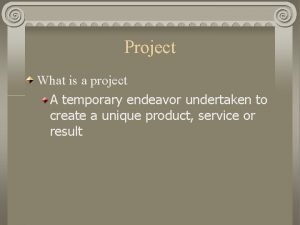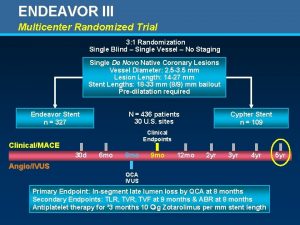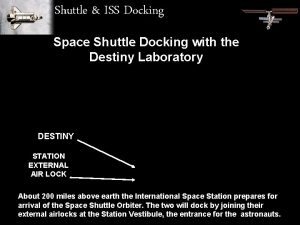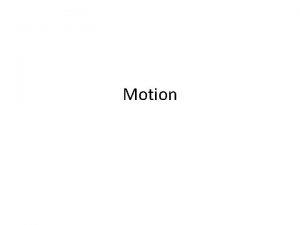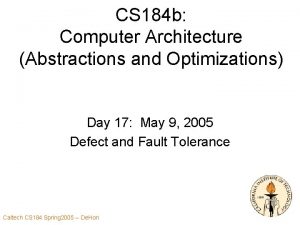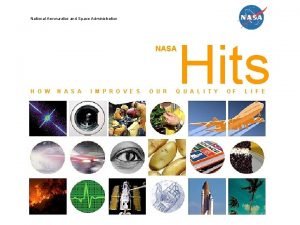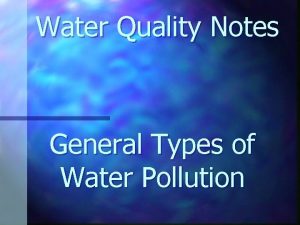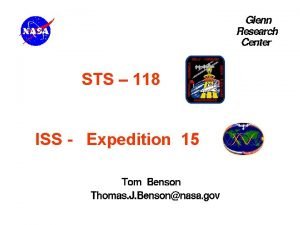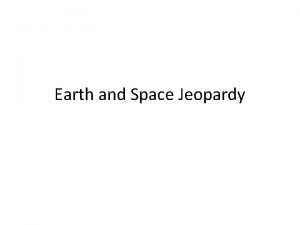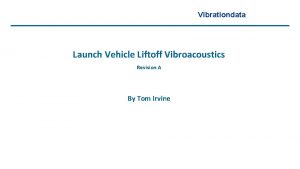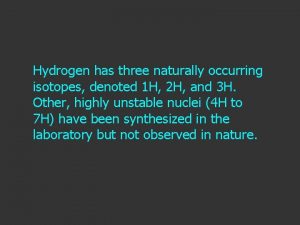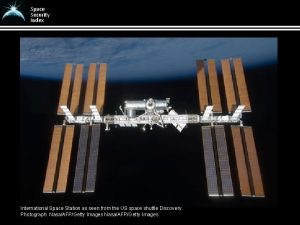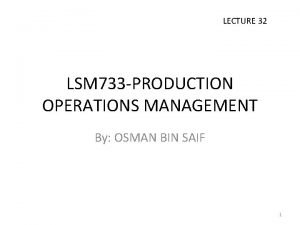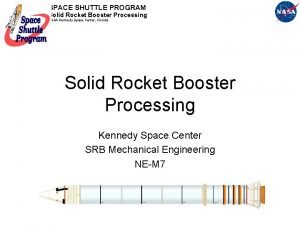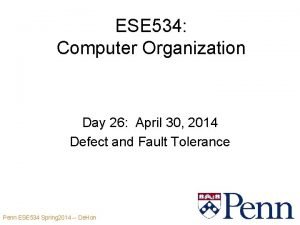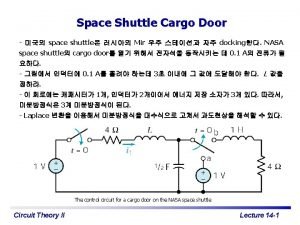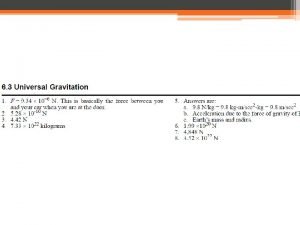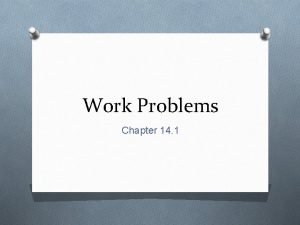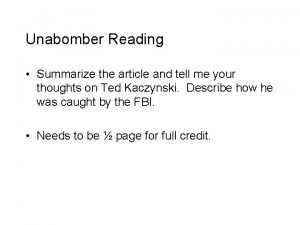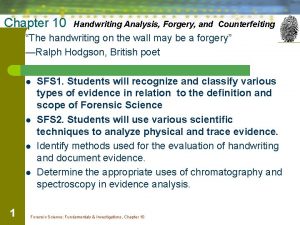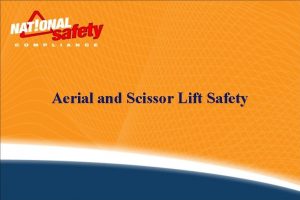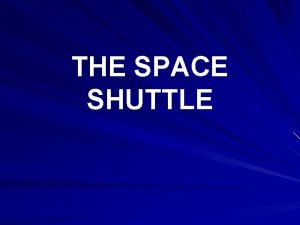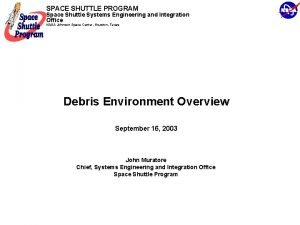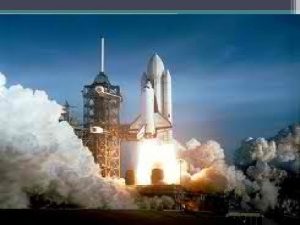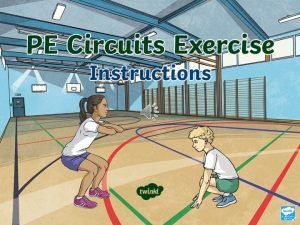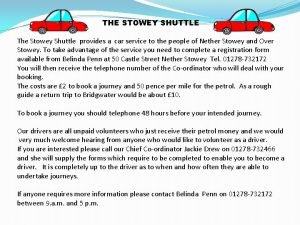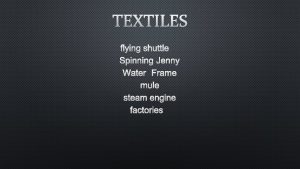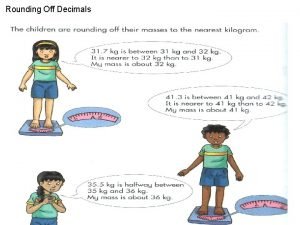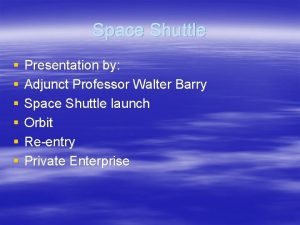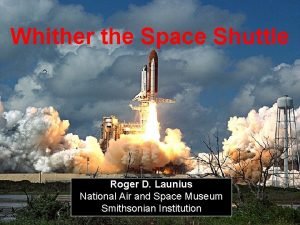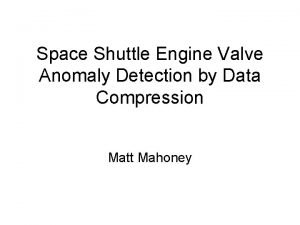The space shuttle Endeavor lifts off for an









































- Slides: 41

The space shuttle Endeavor lifts off for an 11 -day mission in space. All of Newton’s laws of motion - the law of inertia, actionreaction, and the acceleration produced by a resultant force are exhibited during this lift-off. Credit: NASA Marshall Space Flight Center (NASA- NASA MSFC).

Objectives: After completing this module, you should be able to: • Write Newton’s second law using appropriate units for mass, force, and acceleration. • Demonstrate your understanding of the distinction between mass and weight. • Draw free-body diagrams for objects at rest and in motion. • Apply Newton’s second law to problems involving one or more bodies in constant acceleration.

Newton’s First Law Reviewed Newton’s First Law: An object at rest or an object in motion at constant speed will remain at rest or at constant speed in the absence of a resultant force. A glass is placed on a board and the board is jerked quickly to the right. The glass tends to remain at rest while the board is removed.

Newton’s First Law (Cont. ) Newton’s First Law: An object at rest or an object in motion at constant speed will remain at rest or at constant speed in the absence of a resultant force. Assume glass and board move together at constant speed. If the board stops suddenly, the glass tends to maintain its constant speed.

Understanding the First Law: Discuss what the driver experiences when a car accelerates from rest and then applies the brakes. (a) The driver is forced to move forward. An object at rest tends to remain at rest. (b) Driver must resist the forward motion as brakes are applied. A moving object tends to remain in motion.

Newton’s Second Law: • Second Law: Whenever a resultant force acts on an object, it produces an acceleration: an acceleration that is directly proportional to the force and inversely proportional to the mass.

Acceleration and Force With Zero Friction Forces Pushing the cart with twice the force produces twice the acceleration. Three times the force triples the acceleration.

Acceleration and Mass Again With Zero Friction F F a a/2 Pushing two carts with same force F produces one-half the acceleration. The acceleration varies inversely with the amount of material (the mass).

Measuring Mass and Force The SI unit of force is the newton (N) and the unit for mass is the kilogram (kg). Before presenting formal definitions of these units, however, we will conduct an experiment by slowly increasing the force on a given object. Although the force in newtons will become our standard, we begin by using the more familiar unit of force--the pound (lb).

Force and Acceleration DF F DF Da = Constant 8 lb Da 4 ft/s 2 =2 lb ft/s 2 a Inertia or mass of 1 slug = 1 lb/(ft/s 2) Mass m = 2 slugs

Comparing the Newton to the Pound 1 N = 0. 225 lb 1 lb = 4. 45 N 1 lb 4. 45 N A 160 -lb person weighs about 712 N A 10 -N hammer weighs about 2. 25 lb

Example 1: What resultant force F is required to give a 6 kg block an acceleration of 2 m/s 2? a = 2 m/s 2 6 kg F=? F = ma = (6 kg)(2 m/s 2) F = 12 N Remember consistent units force, mass, and acceleration in all problems.

Example 3. A net force of 4. 2 x 104 N acts on a 3. 2 x 104 kg airplane during takeoff. What is the force on the plane’s 75 -kg pilot? First we find the acceleration a of plane. F = 4. 2 x 104 N F = ma + m = 3. 2 x 104 kg a = 1. 31 m/s 2 To find F on 78 -kg pilot, assume same acceleration: F = ma = (75 kg)(1. 31 m/s 2); F = 98. 4 N

Consistent Units (Cont. ) When we say that the acceptable units force and mass are the newton and the kilogram, we are referring to their use in physical formulas. ( Such as F = m a) The centimeter, the milligram, the mile, and the inch may be useful occasionally in describing quantities. But they should not be used in formulas.

Example 4. A 54 -gm tennis ball is in contact with the racket for a distance of 40 cm as it leaves with a velocity of 48 m/s. What is the average force on the ball? First, draw sketch and list given quantities: Given: vo = 0; vf = 48 m/s x = 40 cm; m = 54 gm a=? Consistent units require converting grams to kilograms and centimeters to meters: Given: vo = 0; vf = 48 m/s x = 0. 40 m; Cont. . . m = 0. 0540 km; a = ?

Example 4 (Cont). A 54 -gm tennis ball is in contact with the racket for a distance of 40 cm as it leaves with a velocity of 48 m/s. What is the average force on the ball? Knowing that F = m a, we need first to find acceleration a: 0 F = ma F= (0. 054 kg)(2880 m/s 2); F = 156 N

Weight and Mass • Weight is the force due to gravity. It is directed downward and it varies from location to location. • Mass is a universal constant which is a measure of the inertia of a body. F = m a so that: W = mg and m = W g

Weight and Mass: Examples • What is the weight of a 10 -kg block? 10 kg W = mg = (10 kg)(9. 8 m/s 2) m 9. 8 m/s 2 W W = 98 N • What is the mass of a 64 -lb block? W = mg 32 ft/s 2 64 lb

Mass is Constant; W Varies. 49 N 4. 9 m/s 2 32 lb 16 ft/s 2 98 N 9. 8 m/s 2 64 lb 32 ft/s 2 Earth m= W g = 10 kg Earth m= W g = 2 slugs

Inconsistent Usage (Cont. ) Even metric units are used inconsistently. Mass in kg is often treated as if it were weight (N). This is sometimes called the kilogram-force. F 10 kg A chemist might be asked to weigh out 200 g of a certain element. Also, you hear about a 10 -kg load as if it were weight. The kilogram is a mass - never a force - and it doesn’t have direction or vary with gravity.

Always Remember!! In Physics, the use of Newton’s second law and many other applications makes it absolutely necessary to distinguish between mass and weight. Use the correct units! Metric SI units: Mass is in kg; weight is in N. USCU units: Mass is in slugs; weight is in lb. Always give preference to the SI units.

Example 5. A resultant force of 40 N gives a block an acceleration of 8 m/s 2. What is the weight of the block near the surface of the Earth? a 8 F = 40 N To find weight, we must first find the mass of the block: m/s 2 W=? W = mg Now find weight of a 5 -kg mass on earth. = (5 kg)(9. 8 m/s 2) W = 49. 0 N

Newton’s Third Law (Reviewed): • Third Law: For every action force, there must be an equal and opposite reaction force. Forces occur in pairs. Action Reaction Action

Acting and Reacting Forces • Use the words by and on to study action/reaction forces below as they relate to the hand the bar: Action The action force is exerted by bar the _____ hands on the _____. The reaction force is exerted bar on the _____. hands by the _____ Reaction

Example 6: A 60 -kg athlete exerts a force on a 10 -kg skateboard. If she receives an acceleration of 4 m/s 2, what is the acceleration of the skateboard? Force on runner = -(Force on board) mr ar = -mb ab Force on Board (60 kg)(4 m/s 2) = -(10 kg) ab Force on Runner a = - 24 m/s 2

Review of Free-body Diagrams: • Read problem; draw and label sketch. • Construct force diagram for each object, vectors at origin of x, y axes. • Dot in rectangles and label x and y components opposite and adjacent to angles. • Label all components; choose positive direction.

Example of Free-body Diagram A 300 600 B Ay 30 A 0 Ax B 600 By Bx 4 kg W = mg 1. Draw and label sketch. 2. Draw and label vector force diagram. 3. Dot in rectangles and label x and y components opposite and adjacent to angles.

Applying Newton’s Second Law • Read, draw, and label problem. • Draw free-body diagram for each body. • Choose x or y-axis along motion and choose direction of motion as positive. • Write Newton’s law for both axes: SFx = m ax SFy = m ay • Solve for unknown quantities.

Example 7: A cart and driver have a mass of 120 kg. What force F is required to give an acceleration of 6 m/s 2 with no friction? 1. Read problem and draw a sketch. Diagram for Cart: n W F + x 2. Draw a vector force diagram and label forces. 3. Choose x-axis along motion and indicate the right direction as positive (+).

Example 7 (Cont. ) What force F is required to give an acceleration of 6 m/s 2? 4. Write Newton's Law equation for both axes. m = 120 kg Diagram for cart: n F W ay = 0 n-W=0 The normal force n is SFy = 0; equal to weight W + x SFx = max; F = ma F = (120 kg)(6 m/s 2) F = 720 N

Example 8: What is the tension T in the rope below if the block accelerates upward at 4 m/s 2? (Draw sketch and free-body. ) T a 10 kg a = +4 m/s 2 T mg + SFx = m ax = 0 (No info) S F y = m a T - mg = m a mg = (10 kg)(9. 8 m/s) = 98 N m a= (10 kg)(4 m/s) = 40 N T - 98 N = 40 N T = 138 N

Example 9: In the absence of friction, what is the acceleration down the 300 incline? n n + mg sin 600 W mg cos 0 60 300 mg SFx = m ax mg cos 600 = m a a = g cos 600 a = (9. 8 m/s 2) cos 600 a = 4. 9 m/s 2

Example 10. Two-Body Problem: Find tension in the connecting rope if there is no friction on the surfaces. 12 N 2 kg 4 kg Find acceleration of system and tension in connecting cord. First apply F = ma to entire system (both masses). n S Fx = ( m 2 + m 4) a 12 N = (6 kg) a ( m 2 + m 4) g a= 12 N 6 kg a = 2 m/s 2

Example 10 (Cont. ) The two-body problem. 12 N 2 kg 4 kg Now find tension T in connecting cord. Apply F = m a to the 2 kg mass where a = 2 m/s 2. n T S Fx = m 2 a T = (2 kg)(2 m/s 2) m 2 g T=4 N

Example 10 (Cont. ) The two-body problem. 2 kg 4 kg 12 N Same answer for T results from focusing on 4 -kg by itself. Apply F = m a to the 4 kg mass where a = 2 m/s 2. T n 12 N m 2 g S Fx = m 4 a 12 N - T = (4 kg)(2 m/s 2) T=4 N

Example 11 Find acceleration of system and tension in cord for the arrangement shown. First apply F = m a to entire system along the line of motion. 2 kg S Fx = ( m 2 + m 4) a n 4 kg T m 4 g = ( m 2 + m 4) a +a T m 2 g m 4 g Note m 2 g is balanced by n. a= m 4 g m 2 + m 4 = (4 kg)(9. 8 m/s 2) 2 kg + 4 kg a = 6. 53 m/s 2

Example 11 (Cont. ) Now find the tension T given that the acceleration is a = 6. 53 m/s 2. To find T, apply F = m a to just the 2 kg mass, ignoring 4 kg. 2 kg n 4 kg T +a T m 2 g m 4 g T = (2 kg)(6. 53 m/s 2) T = 13. 1 N Same answer if using 4 kg. m 4 g - T = m 4 a T = m 4(g - a) = 13. 1 N

Example 11. Find the acceleration of the system shown below. (The Atwood machine. ) First apply F = ma to entire system along the line of motion. S Fx = ( m 2 + m 5) a 2 kg 5 kg +a T a = 4. 20 m/s 2 T m 2 g m 5 g

Summary Newton’s First Law: An object at rest or an object in motion at constant speed will remain at rest or at constant speed in the absence of a resultant force. Newton’s Second Law: A resultant force produces an acceleration in the direction of the force that is directly proportional to the force and inversely proportional to the mass. Newton’s Third Law: For every action force, there must be an equal and opposite reaction force. Forces occur in pairs.

Summary: Procedure N = (kg)(m/s 2) • Read, draw and label problem. • Draw free-body diagram for each body. • Choose x or y-axis along motion and choose direction of motion as positive. • Write Newton’s law for both axes: SFx = m ax SFy = m ay • Solve for unknown quantities.

CONCLUSION: Chapter 7 Newton’s Second Law of Motion
 Temporary endeavor
Temporary endeavor Deathmi
Deathmi Catguru endeavor
Catguru endeavor Nasa space shuttle
Nasa space shuttle Space shuttle iss docking
Space shuttle iss docking Http://teachertech.rice.edu/participants/louviere/newton/
Http://teachertech.rice.edu/participants/louviere/newton/ Nasa space shuttle
Nasa space shuttle Space shuttle discovery
Space shuttle discovery Nasa space shuttle
Nasa space shuttle Lifeshears
Lifeshears Questions about water pollution
Questions about water pollution Space shuttle discovery
Space shuttle discovery Nasa space shuttle
Nasa space shuttle Nasa space shuttle
Nasa space shuttle Science jeopardy
Science jeopardy Nasa space shuttle
Nasa space shuttle Vibrationdata
Vibrationdata Space shuttle main engine
Space shuttle main engine Space shuttle discovery
Space shuttle discovery Space shuttle discovery
Space shuttle discovery The following presentation
The following presentation Nasa space shuttle
Nasa space shuttle Solid rocket booster processing stacking
Solid rocket booster processing stacking Nasa space shuttle
Nasa space shuttle Impulse momentum
Impulse momentum Elbows off the table fingers off the food song
Elbows off the table fingers off the food song Pen lifts and separation
Pen lifts and separation A student lifts a 50 pound ball 4 feet in 5 seconds
A student lifts a 50 pound ball 4 feet in 5 seconds Tide proverb
Tide proverb A student lifts a 50 pound ball 4 feet in 5 seconds
A student lifts a 50 pound ball 4 feet in 5 seconds A person lifts a 950 n box
A person lifts a 950 n box A 45n girl sits on a 8n bench
A 45n girl sits on a 8n bench Flourishes and embellishments in handwriting
Flourishes and embellishments in handwriting A 190 000 w engine can accelerate
A 190 000 w engine can accelerate Pen lifts and separation
Pen lifts and separation Used sissor lifts
Used sissor lifts Tobinskatten för och nackdelar
Tobinskatten för och nackdelar Tack för att ni lyssnade bild
Tack för att ni lyssnade bild Vad är referatmarkeringar
Vad är referatmarkeringar Byggprocessen steg för steg
Byggprocessen steg för steg Punkthöjd karttecken
Punkthöjd karttecken Fimbrietratt
Fimbrietratt
